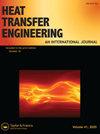Performance Evaluation of Different Desiccant Matrix Materials Coated with Silica Gel
IF 1.6
4区 工程技术
Q3 ENGINEERING, MECHANICAL
引用次数: 0
Abstract
ABSTRACTExcessive cooling of air is required in conventional air conditioning systems to reduce the humidity, leading to the development of desiccant wheel-based air conditioning systems. The desiccant wheel consists of desiccant material which is deposited on matrix material. In this study, aluminum, magnesium alloy, Teflon and fiberglass have been considered matrix materials of the desiccant wheel. A one-dimensional mathematical model has been developed to evaluate the effect of these matrix materials. The results show that fiberglass can be selected as a suitable matrix material for drying applications because it has maximum moisture removal (1.92 g/kg) and temperature difference (4.72 °C) at optimal rotational speed, which are desirable for drying. While aluminum can be selected as a suitable matrix material for air conditioning applications because, at the optimal rotational speed, it has lower maximum moisture removal (1.26 g/kg) and temperature difference (3.14 °C) as compared to other matrix materials. As moderate maximum moisture removal and lower temperature difference are the requirements for air conditioning. A similar trend of results has been also obtained for other parameters (volume ratio, regeneration velocity, regeneration temperature, etc.) of this study.DisclaimerAs a service to authors and researchers we are providing this version of an accepted manuscript (AM). Copyediting, typesetting, and review of the resulting proofs will be undertaken on this manuscript before final publication of the Version of Record (VoR). During production and pre-press, errors may be discovered which could affect the content, and all legal disclaimers that apply to the journal relate to these versions also. AcknowledgementWe thank the reviewers for providing helpful comments on earlier drafts of the manuscript. We sincerely appreciate all valuable comments and suggestions, which helped us improve the manuscript's quality.Additional informationNotes on contributorsLaxmikant YadavLaxmikant Yadav is working as an Assistant Professor at the Department of Mechanical Engineering, National Institute of Technology Hamirpur, Himachal Pradesh, India. He obtained his Doctorate and Master of Engineering from NIT Kurukshetra. His research area includes desiccant dehumidification systems and refrigeration & air conditioning. He has ten years of teaching experience. Ajay SharmaAjay Sharma has completed his Master of Technology in Energy Technology under the guidance of Dr. Laxmikant Yadav in 2022 from National Institute of Technology, Hamirpur, Himachal Pradesh, India. Ravi PratapRavi Pratap has completed Master of Technology in Mechanical Engineering under the guidance of Dr. Laxmikant Yadav from Madan Mohan Malaviya University of Technology, Gorakhpur, U.P, India. Shubham Kumar MishraShubham Kumar Mishra has completed his Master of Technology in Mechanical Engineering (Thermal) from National Institute of Technology, Hamirpur, Himachal Pradesh, India, in 2022. Ashutosh Kumar VermaAshutosh Kumar Verma is currently pursuing the Ph.D. degree in Mechanical Engineering Department of National Institute of Technology Hamirpur, Himachal Pradesh, India. His area of interest includes refrigeration & heat, ventilation, and air conditioning, and desiccant dehumidification. He has six years of teaching experience in the private engineering college of Dr. A.P.J. Abdul Kalam Technical University Uttar Pradesh.硅胶包覆不同干燥剂基质材料的性能评价
摘要传统的空调系统需要对空气进行过度冷却以降低湿度,这导致了以干燥剂轮为基础的空调系统的发展。该干燥剂轮由沉积在基体材料上的干燥剂组成。本研究以铝、镁合金、特氟龙和玻璃纤维作为干燥剂轮的基体材料。建立了一个一维数学模型来评价这些基体材料的影响。结果表明,由于玻璃纤维在最佳转速下具有最大的除湿性(1.92 g/kg)和最大的温差(4.72°C),因此可以选择作为干燥应用的合适基质材料。而铝可以作为空调应用的合适基体材料,因为在最佳转速下,与其他基体材料相比,铝具有较低的最大除湿性(1.26 g/kg)和温差(3.14°C)。由于适度的最大除湿和较低的温差是空调的要求。本研究的其他参数(体积比、再生速度、再生温度等)也得到了类似的结果趋势。免责声明作为对作者和研究人员的服务,我们提供了这个版本的已接受的手稿(AM)。在最终出版版本记录(VoR)之前,将对该手稿进行编辑、排版和审查。在制作和印前,可能会发现可能影响内容的错误,所有适用于期刊的法律免责声明也与这些版本有关。感谢审稿人对初稿提供的有益意见。我们真诚地感谢所有宝贵的意见和建议,帮助我们提高了稿件的质量。本文作者laxmikant Yadav是印度喜马偕尔邦哈米尔普尔国立理工学院机械工程系的助理教授。他获得了NIT Kurukshetra的工程博士和硕士学位。他的研究领域包括干燥剂除湿系统和制冷空调。他有十年的教学经验。Ajay Sharma于2022年在印度喜马偕尔邦哈米尔普尔国立理工学院的Laxmikant Yadav博士的指导下完成了能源技术硕士学位。Ravi Pratap在印度北方邦Gorakhpur Madan Mohan Malaviya理工大学Laxmikant Yadav博士的指导下完成了机械工程硕士学位。Kumar Mishra于2022年在印度喜马偕尔邦哈米尔普尔国家理工学院完成了机械工程(热能)硕士学位。Ashutosh Kumar Verma目前在印度喜马偕尔邦哈米尔普尔国立理工学院机械工程系攻读博士学位。他感兴趣的领域包括制冷和加热,通风,空调和干燥剂除湿。他在Dr. A.P.J. Abdul Kalam Technical University Uttar Pradesh的私立工程学院有六年的教学经验。
本文章由计算机程序翻译,如有差异,请以英文原文为准。
求助全文
约1分钟内获得全文
求助全文
来源期刊

Heat Transfer Engineering
工程技术-工程:机械
CiteScore
4.50
自引率
17.40%
发文量
111
审稿时长
7.5 months
期刊介绍:
Publishing 18 issues per year, Heat Transfer Engineering is an unparalleled resource for key advances in the field of heat transfer for the practicing engineer and other workers in the field. The journal publishes analytical, numerical, and experimental articles of lasting interest in the general area of heat-mass transfer and the related fluid mechanics and thermodynamics.
In a clear, easy-to-read format, the journal includes refereed papers of original work, state-of-the-art reviews, articles on new developments in equipment or practices, reviews of fundamentals, heat in history articles, book reviews, news items on people and companies in the field, advertising, and any other items that may be appropriate.
All submitted manuscripts are subject to initial appraisal by the Editor and/or selected members of the Editorial Board, and, if found suitable for further consideration, to peer review by independent, anonymous expert referees.
 求助内容:
求助内容: 应助结果提醒方式:
应助结果提醒方式:


